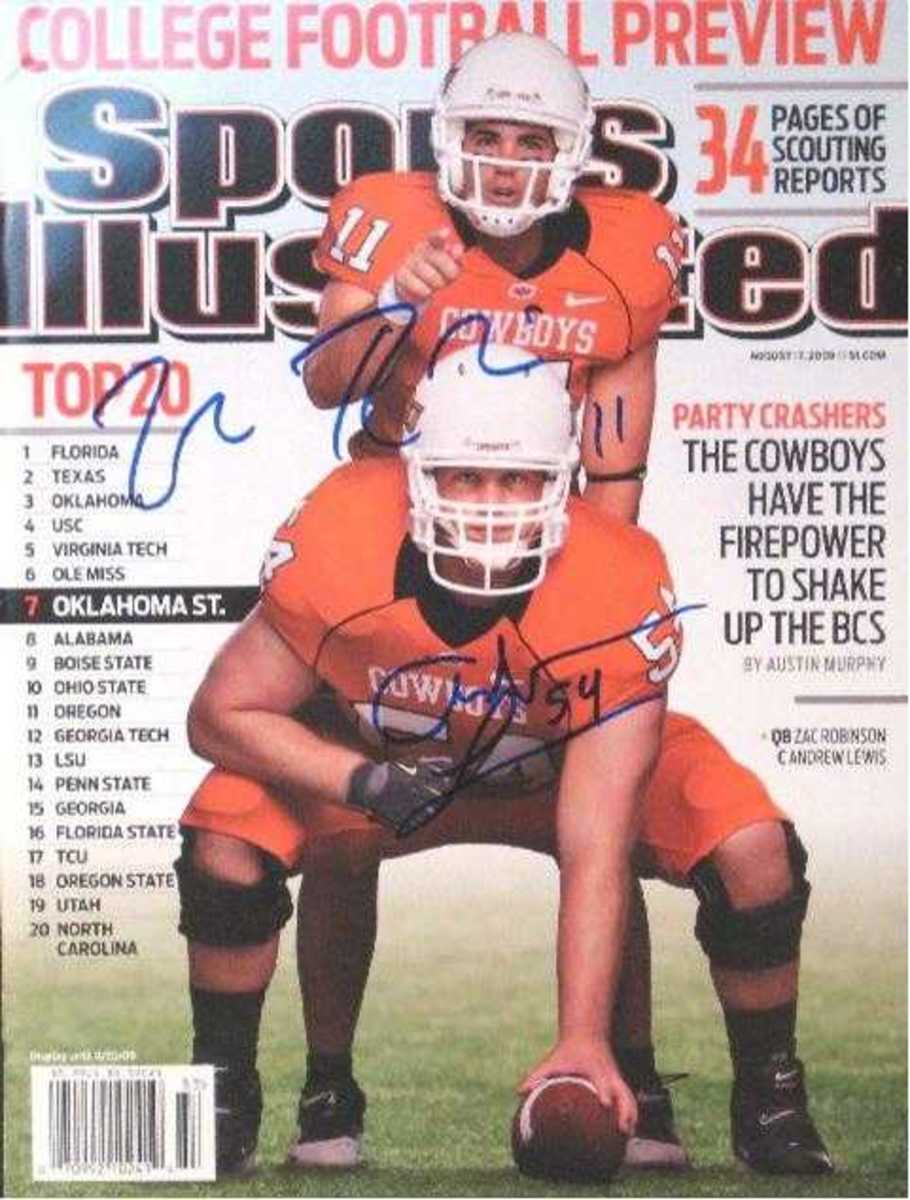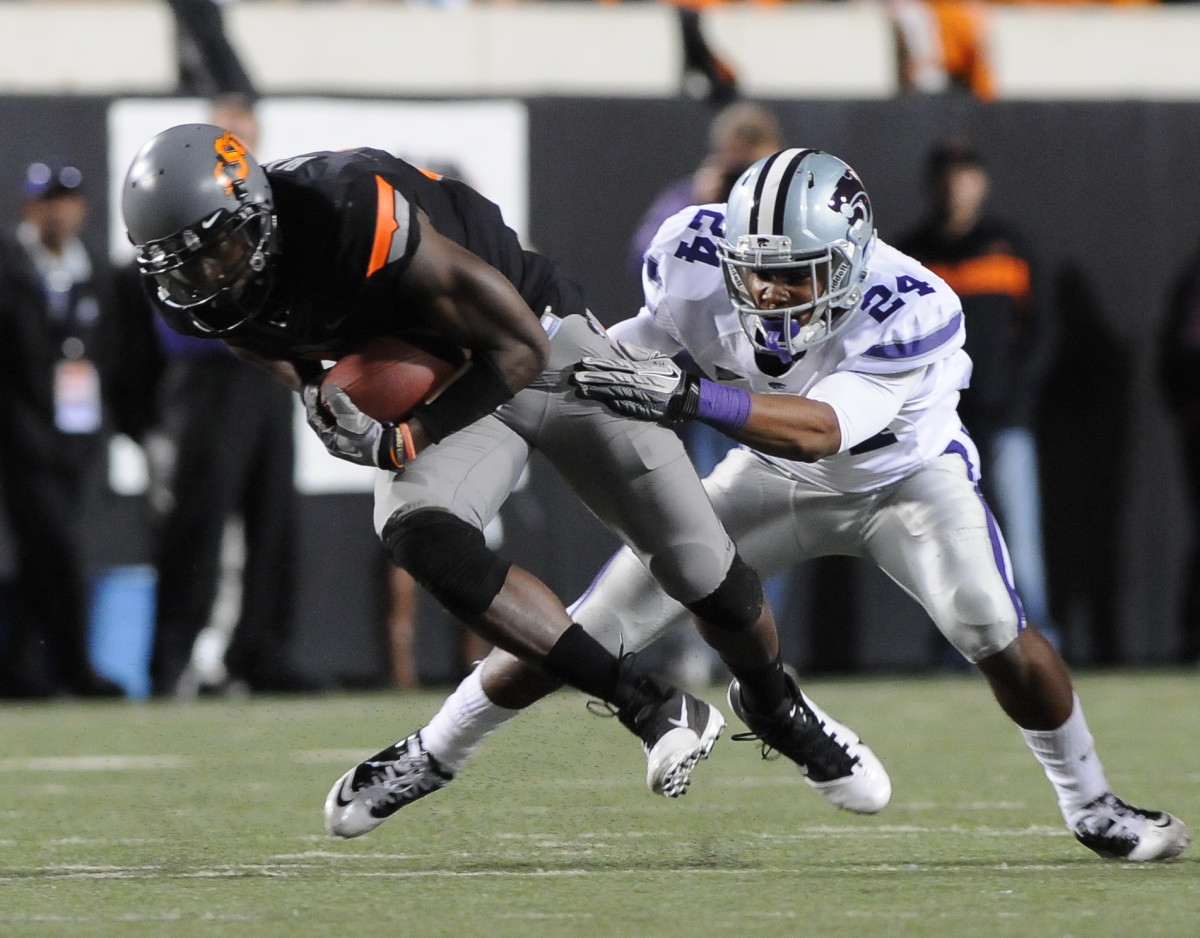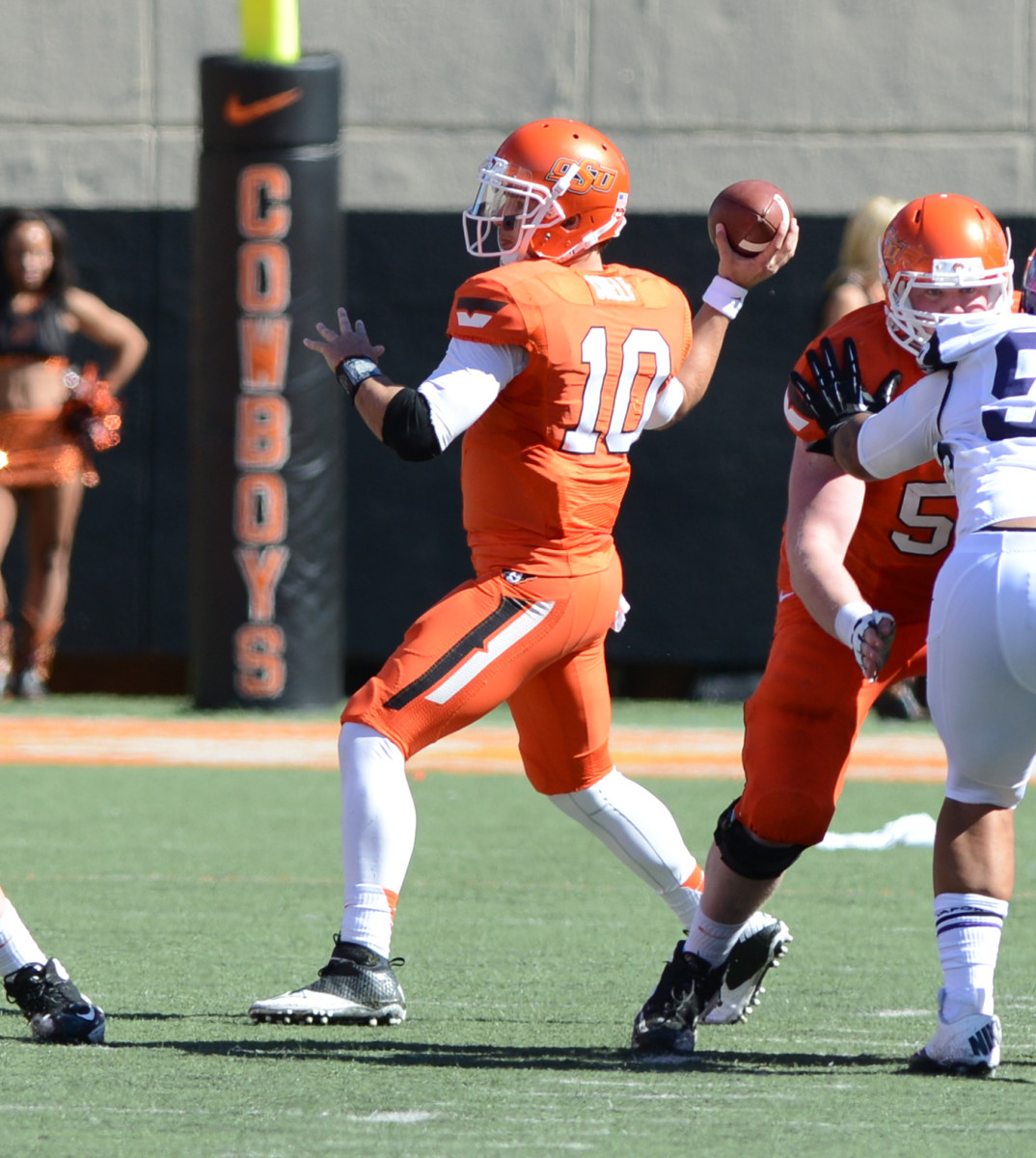A Thorough Examination of Oklahoma State Football Recruiting Under Mike Gundy
STILLWATER -- There is no denying that the Mike Gundy era of Oklahoma State football has been the most successful in school history. Each season builds on a streak of what is now 14-straight winning seasons and 14 trips to bowl games. Gundy, his staff, and his players have been fueled by unprecedented facilities funded by massive and generous donations from many, but primarily the late T. Boone Pickens. University Vice-President and athletics director Mike Holder started his tenure with an emphasis placed on football. The budget for the sport increased. Oklahoma State shot out ahead of many and the recruiting rankings showed that.
Lately, the rankings have backed up, the record did for the 2018 and 2019 seasons. If you look at the corresponding recruiting rankings, they began backing up from a long run of nine recruiting cycles being ranked between 18-and-34. The rankings for the 2015 and 2016 classes were 40th and 45th respectively, but this week The Athletic re-ranked the FBS recruiting classes for 2016 and Oklahoma State was 19th.
In recruiting, hindsight is indeed 20/20. We all love the rankings of the classes and the stars on recruits, but these rankings are often slanted to blue-blood football schools and recruits that are recruited by the blue-bloods and/or prospects that garner a lot of publicity from any variety of sources.
It is often hard to explain how recruits can gain value, or lose value, in between seasons and during periods where they don't play games. It is not unusual for a prospect to pick up a star, even two or three the day after a certain school offers them a scholarship.
Fans love to weigh in and with a head coach like Mike Gundy that is loved by many, appreciated by most, and, for some unknown reasons, loathed by some; there will be polarizing critiques, even from within the athletic department and certainly from the media.
I believe that Gundy and his staff, now including an expanded recruiting staff with Todd Bradford heading up evaluation and Mike Groce specializing in organization, have had success, even some greater success recently because of Gundy's understanding of the geography, the psychology, and the lifestyle aspects of recruiting to Oklahoma State and Stillwater, Okla.
Personally, I got into this exercise of studying football recruiting because I love the game, particularly the two levels involved here: high school and college. I've done this on my own with publications like BG12 and Go Pokes magazines. I have served as the Midlands and Southwest editor for Allen Wallace's SuperPrep magazine. I have worked for Scout and 247Sports in regional capacities and covered more camps, combines, and games than I would care to take the time to count.
I enjoy the sociological aspects of what makes prospects make the decisions they make on where to go to school. I love to study and try to master the art of evaluating 16, 17, and 18-year-old football players and project where they will be as 19, 20, 21, and 22-year-old football players.
Oklahoma State is certainly an intriguing situation to cover and examine.
Here were the ground rules for our examination. We looked at each of the classes between 2005 and 2016. Anything after 2016, and in some ways 2016, is subject to changes. We'll be able to add classes to this each year, for instance 2017 could be looked at pretty thorough this time next year.
We used the 247 Composite and prior to it's existence, we just used 247. They are the most complete entity out there. We divided the classes into 4-star, 3-star, 2-star, and unrated signees.
Each class, by stars, got a batting average and this computed how many of the signees actually contributed to the program.
Each class, by stars, got a performance rating. Very simply, each player was given a check if they lettered one or more years, started a year or less, and were at the school at least two seasons. A player was given star status if they lettered three or more seasons, started two seasons or more, or started less than two seasons and were selected all-conference, won a major award, or went in the NFL draft.
Before we get into each class, I think you will find it interesting to see the total numbers, by stars, proving that getting a lot of three star athletes is actually a solid foundation.
Number of Stars | Totals for 2005-2016 | Batting Average by Stars | Performance Rating by Stars |
|---|---|---|---|
4-Stars | 39 signed with 25 contributing | .641 | 55 percent |
3-Stars | 229 signed with 158 contributing | .690 | 52 percent |
2-Stars | 20 signed with 11 contributing | ,550 | 40 percent |
Unrated | 3 signed with 2 contributing | .667 | 67 percent |
Now, we go year by year and to make it a little easier to digest we divided it up in six-year periods, 2005-2010 and then 2011-2016.
Class Year | National Ranking | Big 12 Ranking | 4-Stars Total/Batting Avg./Performance Ranking | 3-Stars Total/Batting Avg./Performance Ranking | 2-Stars Total/Batting Avg./Performance Ranking | Unranked Total/Batting Avg./Performance Ranking |
|---|---|---|---|---|---|---|
2005 | 47 | 9 | 1 / 1.000 / 50 percent | 14 / .857 / 61 percent | 6 / .667 / 58 percent | None |
2006 | 18 | 4 | 5 / .800 / 60 percent | 20 / .450 / 33 percent | 1 / .000 / 0 percent | None |
2007 | 25 | 4 | 4 / .750 / 75 percent | 17 / .647 / 53 percent | 1 / 1.000 / 50 percent | 1/ 1.000 / 100 percent |
2008 | 32 | 5 | 3 / .667 / 67 percent | 21 / .714 / 64 percent | 3 / .333 / 17 percent | None |
2009 | 34 | 5 | 4 / .500 / 50 percent | 17 / .824 / 56 percent | 2 / .500 / 50 percent | 2 / .500 / 50 percent |
2010 | 29 | 5 | 4 / 1.000 / 100 percent | 23 / .565 / 41 percent | None | None |
A quick review. In Mike Gundy's first season, Joe DeForest did a fantastic job of keeping the class together as he was the only assistant on the road fom nearly two weeks as Gundy put together his staff. Ryan McBean was the lone four-star in the class and highlight players included quarterback Zac Robinson, safety Rickey Price, safety/linebacker Andre Sexton, corner Jacob Lacey, punter Matt Fodge (two-star), and center Andrew Lewis (two-star). There weren't many misses, but Eric Priest and Josh Pinaire never contributed much.

In 2006, the Cowboys' ranking went way up, but this class did not hit for as much in the contribution area. Ugo Chinasa and Perrish Cox were four-stars that went on to the NFL. Alex Cate was a four-star quarterback, but many of you know that story. Among the three-stars signed were Dantrell Savage, Keith Toston, Orie Lemon, and Russell Okung. That is an all-star list of three-star signees. Local offensive line prospect and a three star Myron McKinney never played.

The 2007 class proved to be a foundation for the 2011 Big 12 Championship season with the likes of four-star defensive end Richetti Jones. Another four-star that was gone before that 2011 season was Dez Bryant. William Cole was a four-star miss. Three-star standouts included running back Kendall Hunter, center Grant Garner, receiver Josh Cooper, defensive end Jamie Blatnick, and offensive linemen Jonathan Rush and Nick Martinez. The unranked recruit was transfer kicker Dan Bailey, who left Arkansas when they didn't scholarship him.

Justin Blackmon was part of the 2008 class as a three-star along with safety Johnny Thomas, offensive guard Lane Taylor, corner Broderick Brown, kicker Quinn Sharp and two-star receiver Isaiah Anderson. The four-stars included safety Markelle Martin and fullback Kye Staley.
In 2009, running back Jeremy Smith and safety Daytawion Lowe were four-stars that hit and Dexter Pratt and Anthony Morgan didn't. Quarterback Clint Chelf of Enid was a three-star in the class. Then how about offensive tackle Parker Graham as a two-star and offensive tackle Levy Adcock out of NEO A&M Junior College as an unrated signee.

The best four-star class you could imagine came up in the 2010 class with linebacker Shaun Lewis, corner Justin Gilbert, running back Joseph Randle and linebacker Caleb Lavey making it a four-for-four group in producing. Remember quarterbacks Johnny Deaton and Nathan Sorenson? You can't be blamed if you don't because they didn't do anything as Cowboys.
Class Year | National Rank | Big 12 Rank | 4-Stars Total/Batting Avg./Performance Ranking | 3-Stars Total/Batting Avg./Performance Ranking | 2-Stars Total/Batting Avg./Performance Ranking | Unranked Total/Batting Avg./Performance Ranking |
|---|---|---|---|---|---|---|
2011 | 25 | 4 | 2 / .500 / 50 percent | 23 / .565 / 43 percent | None | None |
2012 | 31 | 6 | 5 / .200 / 20 percent | 15 / .933 / 79 percent | 3 / .677 / 33 percent | None |
2013 | 31 | 5 | 3 / .333 / 33 percent | 18 / .722 / 56 percent | 3 / .333 / 17 percent | None |
2014 | 27 | 4 | 5 / .600 / 50 percent | 21 / .714 / 57 percent | 1 / 1.000 / 100 percent | None |
2015 | 40 | 7 | 2 / 1.000 / 75 percent | 19 / .579 / 45 percent | None | None |
2016 | 45 | 7 | 1 / .000 / 0 percent | 21 / .857 / 74 percent | None | None |
Looking back at the classes briefly, J.W. Walsh was part of a 50/50 duo of four-star signees and running back Herschel Sims was the half that didn't last long. Three-stars that came up big included slot receiver Josh Stewart, slot receiver David Glidden, linebacker Ryan Simmons, linebacker Alex Elkins, and defensive tackle and eventual all-purpose jumbo ball carrier James Castleman.
Maybe the worst group of four-stars were highlighted by Michael Wilson, who was a starter and multi-year letterman, but Wes Lunt lasted one season, actually a few games at quarterback before transferring. You will be pressed to remember Greg Brantley as the four-star offensive lineman showed up in the summer, tested and then when he was told there was a workout next, he walked off the field and never came back. Some of the three-stars that year included linebacker Seth Jacobs, corner Kevin Peterson, now Super Bowl champ in Kansas City defensive end Emmanuel Ogbah, defensive tackle Calvin Barnett, cowboy back and offensive lineman Zac Veatch, and Ashton Lampkin.
In 2013 receiver Marcell Ateman was the only four-star contributor as Ra'Shaad Samples transferred to Houston and Naim Mustafa wasn't in Stillwater long enough to unpack. There were some stout defenders among the three-stars including defensive tackle Vincent Taylor, safety Jordan Sterns, safety Tre Flowers, and defensive end Vili Leveni.
Mason Rudolph highlighted the 2014 recruiting class and included in that class were James Washington, Jordan Brailford, Jarrell Owens, Chris Lacy, Justin Phillips, and Ramon Richards. The lone two-star in the class was punter Zach Sinor, who was outstanding until struggling some his senior season. Even one of the busts, Keenen Brown, went on to transfer and be an All-American at Texas State.
There was a 50/50 split with the four-star signees as both stayed and contributed, but Darrion Daniels played a lot and was All-Big Ten at Nebraska in his grad transfer season while quarterback John Kolar is a four-star that never played much at Oklahoma State or at Iowa State as a grad transfer. Chris Carson came on strong at the end of his career before going on to a strong NFL career in Seattle. Center Johnny Wilson and guard Marcus Keyes just wrapped up their careers as multi-year starters.
Tramonda Moore was the lone four-star in the 2016 class that gets much more credit in the recount. Moore never made it anywhere, really. However, from that class linebacker Calvin Bundage still has eligibility and corner Rodarius Williams, defensive tackle Cameron Murray, offensive tackle Teven Jenkins, offensive tackle Dylan Galloway, linebacker Amen Ogbongbemiga, receiver Dillon Stoner, and linebacker Devin Harper are all back for the Cowboys in the 2020 season.
